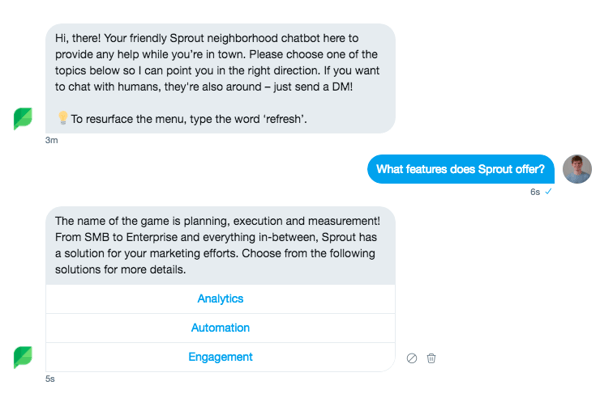The thing about chatbots and the increasing popularity of intelligent personal assistants is that they’re here to make life easier.
From a business perspective, they help you stay competitive. By automating as many key business processes and workflows as possible, SMBs and enterprises are leveraging chatbots as a way to take on the burden of time-consuming tasks, freeing up employees to focus on other priorities.
Chatbots also allow you to offer a 24/7 service, answer customer queries and provide solutions quickly, improving the customer experience overall. In addition, you can configure settings that enable actions like scheduling meetings, generating leads automatically, customizing language, or personalizing your messaging for your audience - even on social media platforms.
Question is, how do you create a good chatbot conversation flow to get the most of this helpful tool? Let’s dive into key tips and a few examples of chatbot conversations that guide users to better outcomes.

Creating Your Conversational Chatbot Flow
Before you bot, you need to map out a framework of your conversation flow. This requires you to draw up every possible scenario and understanding your potential customer’s search queries.
When creating your outline and writing your script, think about where you want your prospects to land. This is important because it could lead them to convert without the help of a sales person like in the examples below.
Consider the following elements you could include in your chatbot conversation:
1. Greeting
This is a no brainer. Just like in the human world, starting off a conversation with a simple ‘Hello, I’m (insert name here). How can I help you?’ sets things up on a positive note. Remember, just because an automated bot is handling customer queries for your business doesn't mean it should sound like one. Make your script sound natural, be brief and cut to the chase.
However, we’d like to point out a crucial part of the bot’s introduction is to be clear of its capabilities—state what it can and can’t do in order to set expectations.
Here’s an example of a chat conversation greeting that leads users to a specific category as a way to provide guidance:

Source: LiveChat
This bot chat aims to humanize the experience with some personality. Here’s your chance to bring in your creative team to craft your bot’s tone and voice that represents your brand’s personality and values.

2. Giving Information
Part of mapping out your conversation strategy is finding the best possible responses. To do this, create multiple responses in your outline for every question you ask the user, making sure that all conversation flows satisfy their needs.
In providing information, you could lead users to conversion. Use call-to-action (CTA) buttons to guide prospects to the proper pages on your website where they will find more information, book a call, connect them to sales, etc.
Here’s how Sprout’s chatbot leverages CTAs:

3. Ending a Chatbot Meaningfully
Your narration should have a beginning, middle and end, just like you would in real conversations. So, it’s important not to skip the conclusion of the conversation. It’s all part of the experience and making users feel like you’re there for them if they need further assistance.
Here are a few ways you can wrap up the conversation:
- “It was great connecting with you today. I’m around if you need any more help!”
- “You’re all set! Is there anything else I can do for you today?” (Yes/No options)
- “Glad to have been of service. Let’s chat more often! I’m always around :)”

Source: Juji Documentation
Conclusion: Less is More
As you begin finding your chatbot’s voice and flow, just remember to keep it simple and be human.
Whether the purpose of your bot is to provide customer service or manage a sales funnel, just say what you need to say in a way that resembles a real conversation!
With a range of chatbots you can implement in your business, like Woebot and Growthbot, you can explore different chat capabilities suited to your goals.
Reach out if you have any questions!
